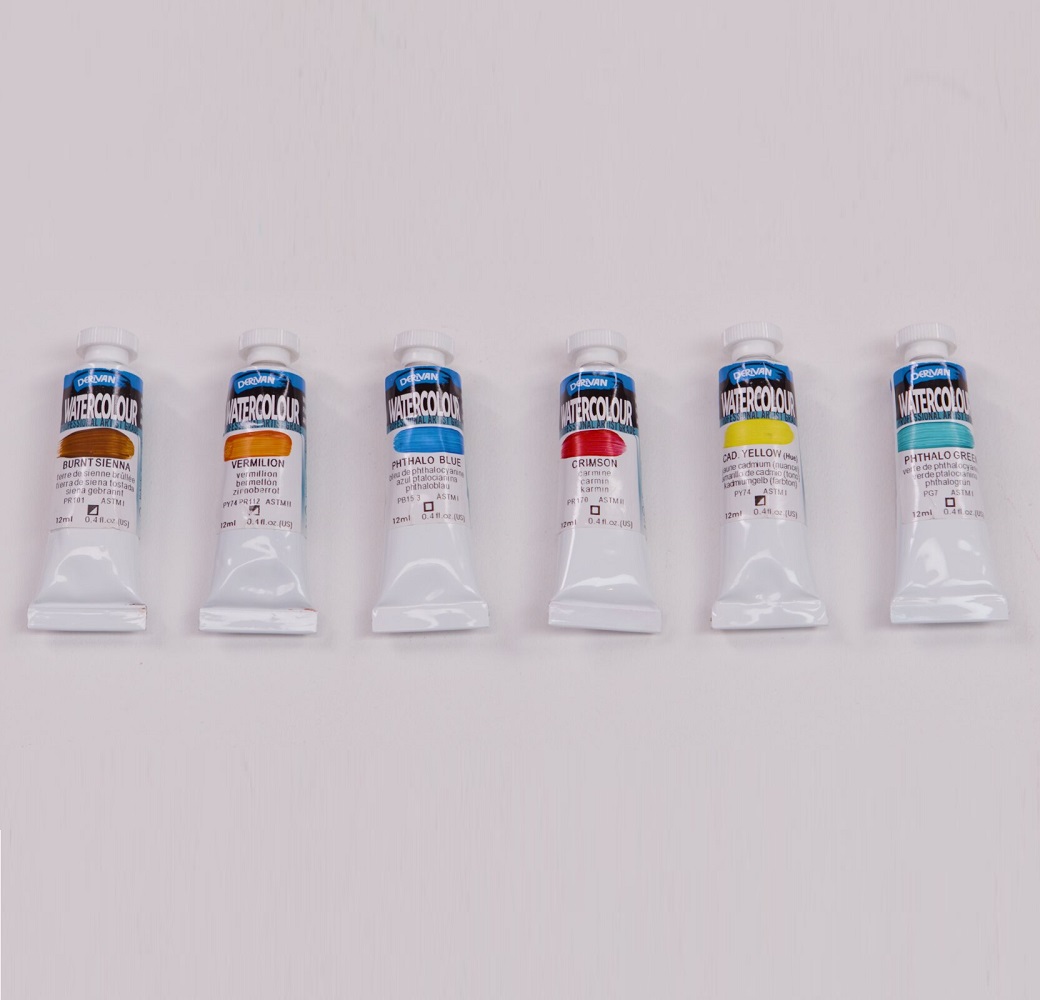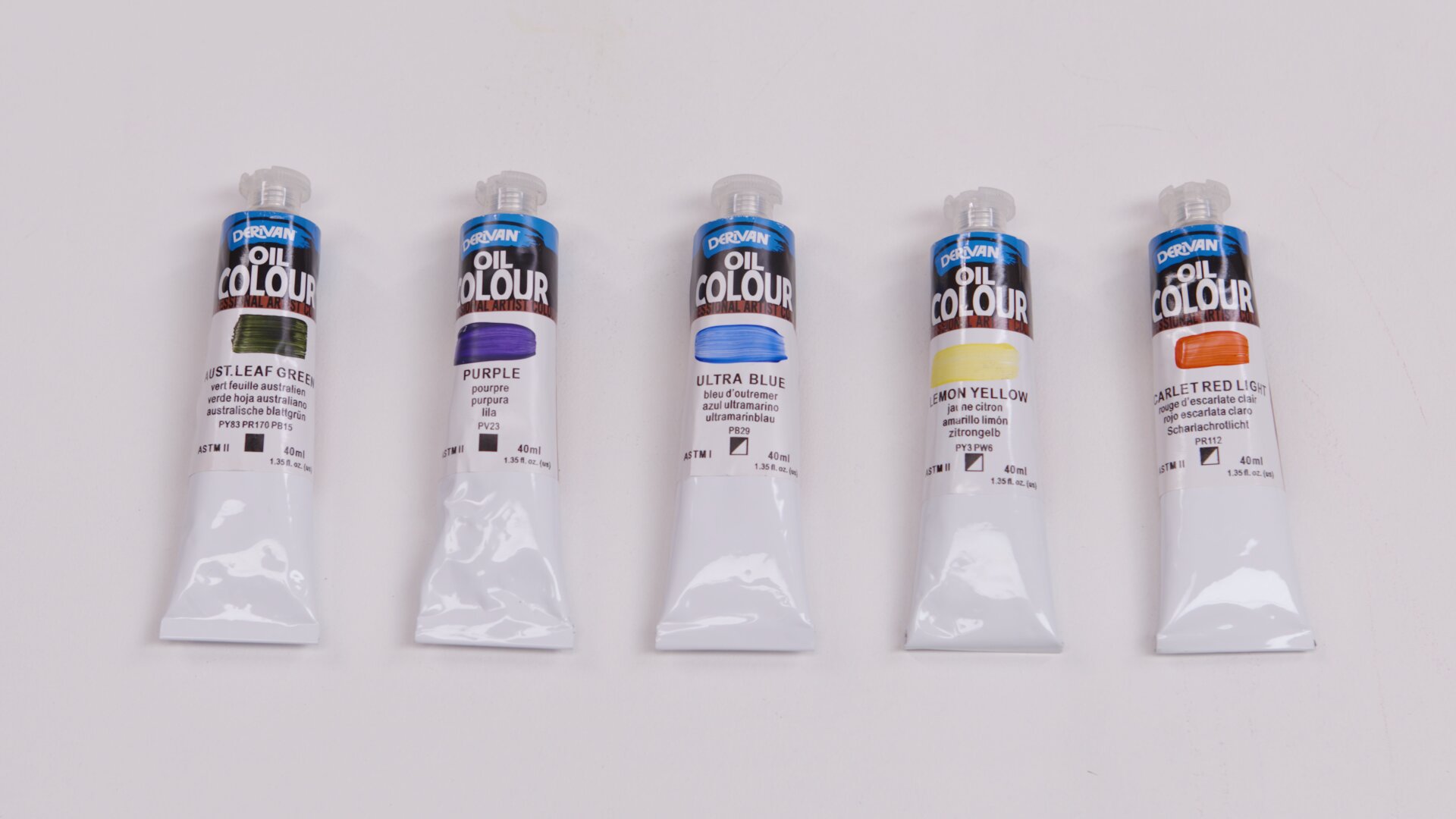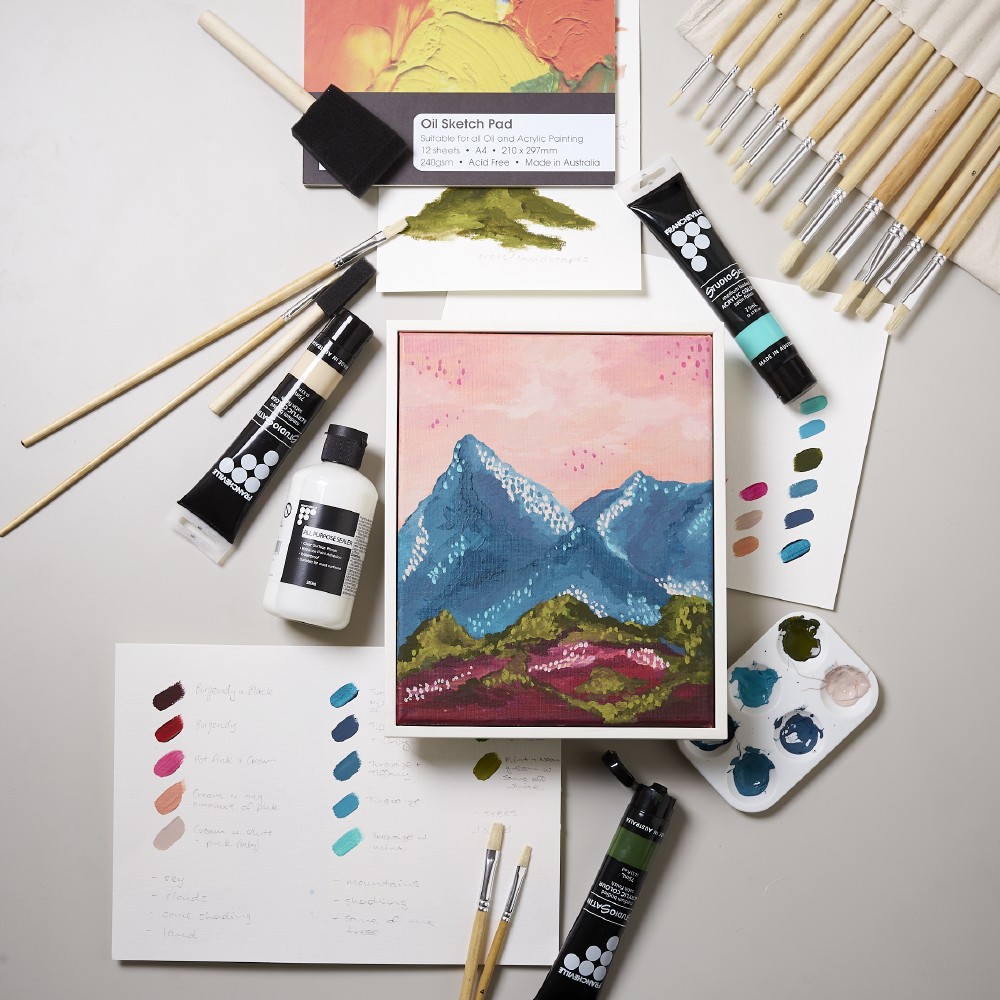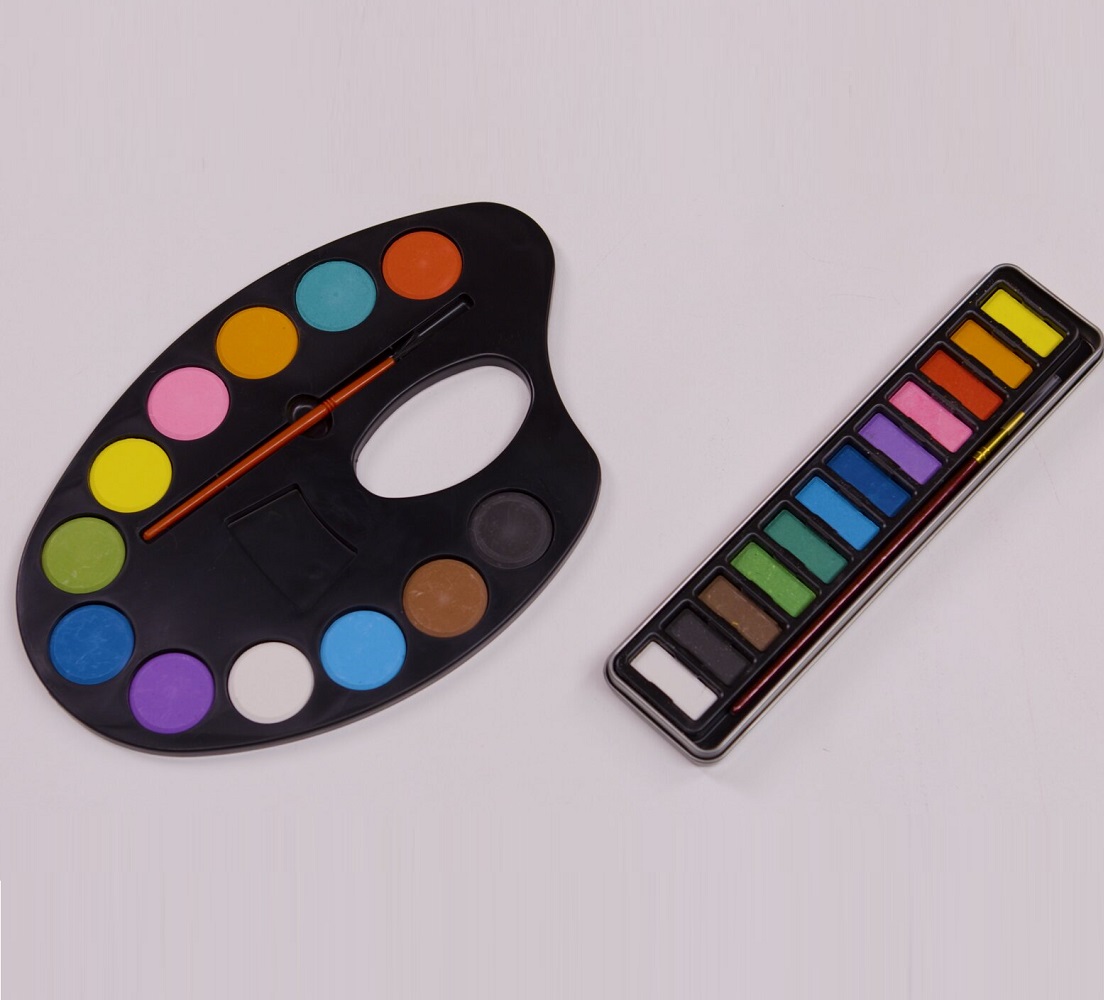 | ||
| Your browser is not supported. | ||
|
Please browse our site using any of the following options:
| ||
Choosing Paint Mediums
From soft and dreamy, to bold and impactful - you can make any kind of art with the right paint! At Spotlight we're delighted to offer you all the most popular kinds of paint on the market, from a variety of well-known brands such as Atelier, Jo Sonja and Reeves. Glowing watercolours, vibrant acrylics, gorgeous gouaches and creamy oil paints are all available in our art paints collection, in a rainbow of colours that you'll love to choose from.
This guide will walk you through each type of paint, how they function and how you can use them, plus what useful tools and accessories you should get with each one.
Quick Links
Watercolour Paint
Watercolour paints are usually composed of pigments dispersed in a binding agent like gum arabic. Other additives are often included to improve various qualities like pigment distribution and shelf life.
Being water soluble makes these paints highly dynamic to work with. The quantity of water and the method of its application can produce a myriad of effects - layering watercolours can produce nuanced, complex results, with subtle variations in depth and tone.
Watercolours are most commonly found in tubes and pans, but they also come in liquid and pencil forms. Each has its advantages and can be used to create different kinds of watercolour art.
Watercolour tubes
- Practical, versatile, and easy to find, these are one of the most commonly used forms of watercolour paint.
- Ideal for artists who make larger artworks, and for creating washes because it's easier to load a brush with larger amounts of paint in one go.
Liquid watercolour
- Liquid watercolours are composed of coloured pigment, a vehicle that holds the pigment in suspension, and distilled water. This means they don't need to be activated by the addition of water.
- They can be used both for painting and for dyeing, as they will stain fabric, wood, paper, or the kinds of craft materials you might use with kids such as rice or foam.
- Liquid watercolours are highly pigmented, so a little goes a long way. They create vivid paintings, but can also be diluted for softer tones.
- They're also excellent for hand lettering, producing smooth, even brushstrokes.


Factors to consider when buying acrylic paints:
- Viscosity: While mediums can alter the consistency or 'body' of your paint, it's worth choosing a starting paint that you don't have to change too much.
- Permanence: This refers to how well the paint responds to exposure to light and humidity over time
- Permanence will vary significantly according to the quality of the paint you choose. Student acrylics are cheaper, but not as permanent. Artist-quality ones cost more but are generally longer lasting.
- Some individual pigments are longer lasting than others, so permanence will vary by colour even within a single brand's range. Most acrylic paints have a permanence rating on the tube, so you will be able to compare colours before you buy.

Watercolour pans
- These watercolours are dry and then activated with water when you want to use them. This makes them easy to transport and use outside or while travelling.
- Palettes and pans are very long-lasting. They're used straight from the pan which means nothing goes to waste.
- Palettes are an excellent way to get a range of colours in one set, without having to select individual tones.
Watercolour pencils
- They look like regular coloured pencils, and when used create colours and lines you'd expect from a regular pencil.
- Activate your watercolour pencil lines by brushing over them with a bit of water. The colours will brighten, bolden and become more transparent.
- You can dip the tip of a watercolour pencil into water before you draw to create soft, smudgy lines. Or coat the paper with a thin wash of water before drawing for another different effect!
Factors to consider when buying watercolour paints:
- Transparency: This quality refers to the extent to which light can pass through the pigment, and bounce off the surface it's painted on.
- Highly transparent paints are ideal for layering, as they will create more depth and complexity of colour as they are layered over each other.
- A good way to test a paint's transparency is to draw a line with a black marker and paint over it. Transparent paints will not show up against the black, while more opaque ones will be visible on top of it.
- Mixing more opaque watercolours with more water can increase their transparency.
- Permanence: This refers to how well the pigment withstands exposure to light and humidity.
- Lightfastness varies according to pigment type, as well as the quantity and type of binders and additives included in the paint.
- Pigment type: This refers to what the pigment is made of. Organic pigments are usually made from minerals and metals, while synthetic pigments are created in a lab from chemicals.
- While any colour can be made by combining the primary colours, they can become muddied and less vibrant with mixing. Using single pigments produces the best results.
- Different colours will vary in cost within each brand's range. This is because some pigments are more easily accessed and produced than others.
Watercolour painting supplies
Here is a quick selection of the supplies you'll need when painting with watercolours:
- Plastic palette: A plastic palette is a good choice for watercolours as it won't absorb the water from your paints like a wooden one might.
- Watercolour paintbrush: Look for a paintbrush that has been designed for use with watercolours. It will hold plenty of water and ensure both water and pigment come out of the brush at an even pace. Synthetic or natural hair brushes are both suitable for watercolour, although avoid very bristly hair brushes like hog hair as they won't hold the water properly.
- Watercolour paper: Paper used for watercolour painting should be thick and durable so it won't bend, tear or buckle under the weight of the water. Cold-pressed paper is rough and textured, gripping your colours in place, whole hot-pressed is smooth and won't absorb your colours quickly, giving you time to work and spread them around if needed.
Read through our blog on watercolour pencils for more information on how to use them successfully!
Acrylic Paint
Acrylic paints are water-soluble, but unlike watercolours, their pigments are bound by acrylic polymer emulsion. This makes them thicker and more opaque. It also means that once dry they are permanent because they're not easily reactivated with water.
The binding agents in acrylic paints are water soluble so they can be thinned with water before use. It also means they can be washed from brushes and surfaces without chemicals, making them great for kids.
Acrylic paints vary in consistency. Some are comparatively thin and runny, while others are thicker with a heavy body. The type you choose will depend on your style of painting, and the effect you want to achieve. Look for words like 'flow' for thinner acrylics and 'impasto' for thicker acrylics.
Acrylic mediums
One of the most appealing qualities of acrylics is that they can be modified with various mediums. For example:
- Gel medium: This is most commonly used to change the consistency of the paint:
- Liquid gel medium will make the paint thinner while maintaining smooth coverage (thinning paint with too much water will create a patchy finish)
- Heavy body medium will thicken the paint's consistency, making it more opaque and brush strokes more visible
- Slow drying medium: Acrylics generally dry quite quickly, which is often a desirable feature, but this medium slows the drying process for when you want to keep them workable for longer.
- Texture medium: These add different textures to your paint and come in loads of varieties including modelling paste, and other finishes like sand, beads, and fibres. They can either be mixed with your paint, or laid down first and then painted over.
- Flow enhancer: This medium has multiple effects:
- Minimises brush marks for a smoother finish
- On absorbent surfaces, it will turn paint into a stain or dye
- It slows down drying time, keeping paint workable for longer
- Can be used to thin paint down for pouring
All mediums come in a range of finishes from matte to glossy, and it's worth taking this into account when selecting them. Read our blog on acrylic paint mediums for more information on the kinds of special effects you can create!
Acrylic painting supplies
When painting with acrylics you'll need:
- Plastic palette: Like watercolours, a plastic palette is useful for acrylic paints because it won't absorb any of the excess water from the paint. You can use a wooden one, but make sure it's only for undiluted acrylic paints and be prepared for stains!
- Synthetic paintbrushes or painting knives: Brushes made with synthetic bristles will hold onto acrylic paint well and can withstand the damage and stains they can sometimes cause natural bristle brushes. If your acrylic is a thick impasto, you can also apply it using a painting knife!
- Canvas or paper: Thick paper with at least 200gsm can be used for acrylic, although for a professional look you may like to paint on a primed canvas! Look for canvases that are stretched and 100% cotton so your artwork will stand the test of time.
Check out our blog on acrylic painting techniques for heaps of fun and exciting ways to use acrylic paint!
Gouache Paint
Gouache paint can be most easily described as an 'opaque watercolour', or a cross between acrylic and watercolour paint. It contains pigment distributed in water and gum arabic, just like watercolours, but it has the addition of chalk or similar white filler. This filler is what creates the opacity that is more like acrylic.
This is a quick-drying medium but can be re-wetted, making it more workable than acrylics and oils. The flip side of this is that layering different colours on top of each other can cause the top layer to lift what's beneath it and create a muddy effect. To layer gouache, make sure your initial layers are thin and make them thicker and less watery as you move up, always make sure a layer is dry before adding another on top!
Gouache painting supplies
If you wish to start painting with gouache, you'll need:
- A plastic palette: Their similarity to watercolours means a plastic palette is the way to go with gouache paint.
- Synthetic paintbrushes: A synthetic paintbrush will hold gouache paint well and will be easier to clean than a natural bristle brush. If you like to paint with watercolours too, make sure to keep the brushes you use for it separate from your gouache brushes, as gouache is a little harder to clean off than watercolour.
- Watercolour paper: A thick and durable watercolour paper will work wonderfully with gouache paints. Avoid very smooth papers like hot pressed, as your thicker gouache paints may slide right off it.
For more information on gouache paint, read our informative blog on gouache paint and how to use it.
Watercolours | Tube | Pan | Liquid |
Illustration | ✓ | ✓ | ✓ |
Fine Art | ✓ | ✓ | X |
Colouring | O | O | O |
Lettering | O | O | ✓ |
Dyeing | X | X | ✓ |
Kid's art | O | ✓ | O |
?: Recommended
O: Usable
X: Not recommended
Oil Paint
Oil paints are made with pigment that's mixed with oil, usually linseed. The oil base causes these paints to dry slowly, allowing artists to work on a painting gradually and make changes and alterations as they go. This same quality makes the paint very blendable, allowing the creation of subtle gradations of colour.
Oil doesn't evaporate the way water does, which means that what is left on the canvas after the paint dries is a flexible polymerised solid.
Oil mediums
As with acrylics, mediums can be added to oil paints to change their consistency, drying time, and finish. For example:
- Turpentine: This is a solvent that will thin oil paint, and speed up drying time. It's also useful for cleaning brushes and surfaces that have paint on them.
- Linseed oil: Produces a glossy or glazed effect when mixed with paint, and slows down drying time.
- Stand oil: A faster drying oil than standard linseed. Thins the paint and reduces both drying time and brush marks.
- Prepared mediums: Blends of solvents and oils, varying in composition depending on the manufacturer, which help dilute oil paint. Being premixed makes them great for beginners.
Factors to consider when buying oil paints:
- Permanence: Oil paint is the most permanent paint medium and is extremely long-lasting. While artist-grade oil paints have higher permanence ratings, many artists use student-grade ones without a noticeable reduction in quality.
- Safety: It's important to note that some pigments used in oil paints are toxic, and many of the associated thinners, cleaners and mediums are highly flammable. These materials should be used with care in a ventilated area and kept out of reach of children.

Oil painting supplies
- A wooden palette: Paint like the masters of old with a wooden palette! You can scrape excess oil paint off a wooden palette once it's dried, or just leave it there are pipe fresh paint on top of it, as you don't need to worry about dried oil colour resetting.
- Natural bristle brushes and painting knives: A thick, strong and bristly paintbrush, such as a hog hair one, is ideal for holding all of that creamy oil paint, You can also apply oil paint in thick swipes and dollops using a painting knife. Use a palette knife to mix the colours on your palette too!
- Canvas or board: Paper isn't strong enough to support the weight of thick and heavy oil paints, so tick to canvas that has been primed for oil paint or special wooden boards for use with this medium.
Check out our painting projects for ideas and inspiration on how to use oil paints at home, and our impasto painting blog on how to use the thickness of oil paint to your advantage.
Discover The Perfect Paint Medium At Spotlight
Grab what you need in pieces online, or have a look at any of our amazing art sets to get everything you need all in one go! Pay online and we'll deliver your art medium straight to your front door, or visit your nearest Spotlight store and our friendly team will help you get all the art supplies you need in person.
Make sure to read our other handy painting blogs, such as how to choose an easel and canvas, which type of paintbrush is best for you and how to paint shadows for beginners.




